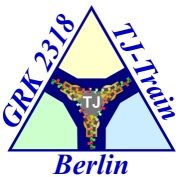
DFG Research Training Group "TJ-Train" (GRK 2318/2) Project
A4
Dr.
Martin Lehmann
Leibniz-Forschungsinstitut für Molekulare Pharmakologie (FMP), Dynamic super-resolution imaging of tight junction components, lipids and Ions The tight junction (TJ) connects neighboring epithelial or endothelial cells and acts as a barrier for solutes, water and pathogens. The TJ protein composition in tissues controls tightness and permeability and is regulated by dynamic protein assemblies, signaling and endocytosis. The central aim of project A4 is to resolve the nanoscale molecular organization of TJs using super-resolution light microcopy and advanced live cell imaging under physiological and pathological conditions. We hypothesize that the nanoscale TJ strand composition and structure is changed by claudin/TAMP composition, toxin exposition, hypoxia and inflammatory responses. In order to understand organization principles and function of different TJ components we will combine STED microscopy with 50 nm resolution, FRET, FLIM, automated confocal microscopy and novel lipid/Ion flux assays with quantitative image analysis. Specifically the dynamic nanoscale organization of all claudins, occludin, ZOs and selected pairs of claudins/occludin will be investigated in tissues, primary cells and CrispR knock-in and knock-out epithelial cell lines. All results will be used to understand disease, knockout phenotypes, pathological conditions and inspire new pharmacological treatments. Close collaborations with other basic and clinical research groups within TJ-Train are planned. 3rd cohort PhD doctoral student 2nd cohort PhD doctoral student Rozemarijn van der Veen
1st cohort PhD doctoral student Hannes Gonschior
Identification of novel disease relevant modulators of the SHH pathway in the developing brain Development Gonschior H, Haucke V, Lehmann M (2020) Super-resolution imaging of tight and adherens junctions: Challenges and open questions. Int. J. Mol. Sci. 21(3): 744 (15 pages) [PubMed] [WebPage] [PDF] (Review) (IF 5.9) Gonschior H, Schmied C, Van der Veen R, Eichhorst J, Himmerkus N, Piontek J, Günzel D, Bleich M, Furuse M, Haucke V, Lehmann M (2022) Nanoscale segregation of channel and barrier claudins enables paracellular ion flux. Nat. Commun. 13(1): 4985 (20 pages). doi: 10.1038/s41467-022-32533-4, Supplement (IF 16.6) Participation with project A4 Priv.-Doz. Dr.
Jörg Piontek
Project-related publications
Gimber N, Tadeus G, Maritzen T, Schmoranzer J, Haucke V (2015) Diffusional spread and confinement of newly exocytosed synaptic vesicle proteins. Koo SY, Kochlamazashvili G, Rost B, Puchkov D, Gimber N, Lehmann M, Tadeus G, Schmoranzer J, Rosenmund C, Haucke V*, Maritzen T* (*co-corresponding authors) (2015) Vesicular synaptobrevin/VAMP2 levels guarded by AP180 control efficient neurotransmission. Lehmann M, Gottschalk B, Puchkov D, Schmieder P, Schwagerus S, Hackenberger CP, Haucke V, Schmoranzer J (2015) Multicolor 'caged' dSTORM resolves the ultrastructure of synaptic vesicles in the brain. Seifert W, Kühnisch J, Maritzen T, Lommatzsch S, Hennies HC, Bachmann S, Horn D, Haucke V (2015) Cohen syndrome-associated protein COH1 physically and functionally interacts with the small GTPase RAB6 at the Golgi complex and directs neurite outgrowth. Podufall J, Tian R, Knoche E, Puchkov D, Walter AM, Rosa S, Quentin C, Vukoja A, Jung N, Lampe A, Wichmann C, Böhme M, Depner H, Zhang YQ, Schmoranzer J, Sigrist SJ, Haucke V (2014) A presynaptic role for the cytomatrix protein GIT in synaptic vesicle recycling. Wilhelm BG, Mandad S, Truckenbrodt S, Kröhnert K, Schäfer C, Rammner B, Koo SJ, Claßen GA, Krauss M, Haucke V, Urlaub H, Rizzoli SO (2014) Composition of synaptic boutons reveals the amounts of vesicle trafficking proteins. Posor Y, Eichhorn-Grünig M, Puchkov D, Schöneberg J, Ullrich A, Lampe A, Müller R, Zar-bakhsh S, Gulluni F, Hirsch E, Krauss M, Schultz C, Schmoranzer J, Noé F, Haucke V (2013) Spatiotemporal control of endocytosis by phosphatidylinositol 3,4-bisphosphate. Lampe A, Haucke V, Sigrist SJ, Heilemann M, Schmoranzer J (2012) Multi-colour direct STORM with red emitting carbocyanines. Maritzen T, Zech T, Schmidt MR, Krause E, Machesky LM, Haucke V (2012) Gadkin negatively regulates cell spreading and motility via sequestration of the actin-nucleating ARP2/3 complex. The listed publications are relevant with respect to the technologies (i.e. super-resolution imaging) and cell systems applied, not the specific biological questions addressed. |